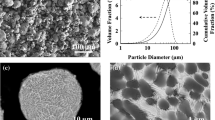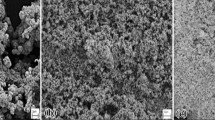Abstract
In this work, aluminum 6061-based powder blend feedstocks with reactive Ti-B/C additions were employed in two different additive manufacturing processes, laser powder bed fusion (L-PBF) and electron beam freeform fabrication (EBF3), to create micro- and nanoscale ceramic and intermetallic inoculants in situ and to examine the effect of feedstock inoculant content on microstructure and mechanical properties. Products of the reaction synthesis process were identified with X-ray diffraction and energy-dispersive spectroscopy to include Al3Ti, TiC, and TiB2. Electron back-scatter diffraction revealed significant grain refinement up to 74\(\times\), mitigation of solidification cracking, and formation of an equiaxed grain structure with the addition of just 2 vol.% inoculant. Inoculants formed in situ were seen to induce approximately 5\(\times\) more grain refinement than pre-existing inoculants. The highest ultimate tensile strength and Young’s modulus of 368 ± 2 MPa and 92.8 ± 1.6 GPa, respectively, were achieved at 10 vol.% inoculant in the L-PBF process. Strengthening mechanism calculations and the tensile data suggest a higher strengthening contribution via modulus mismatch and Orowan strengthening from the particles created by reaction synthesis than from Hall–Petch strengthening through grain refinement.


















Similar content being viewed by others
References
Rawal SP (2001) Metal-matrix composites for space applications. JOM 53(4):14–17. https://doi.org/10.1007/s11837-001-0139-z, http://link.springer.com/10.1007/s11837-001-0139-z
Harun WSW, Kadirgama K, Samykano M, Ramasamy D, Ahmad I, Moradi M (2019) Mechanical behavior of selective laser melting-produced metallic biomaterials. In: Mechanical Behaviour of Biomaterials, Elsevier, pp 101–116. https://doi.org/10.1016/B978-0-08-102174-3.00005-X, https://linkinghub.elsevier.com/retrieve/pii/B978008102174300005X
Liu R, Wang Z, Sparks T, Liou F, Newkirk J (2016) Aerospace applications of laser additive manufacturing. Elsevier Ltd. https://doi.org/10.1016/B978-0-08-100433-3.00013-0
Herderick ED (2011) Additive manufacturing of metals: A review. Materials Science and Technology Conference and Exhibition 2011, MS and T’11 2(176252):1413–1425. http://www.scopus.com/inward/record.url?eid=2-s2.0-84856301323&partnerID=40&md5=e02018d10b2ca37a7e2ae1773e4fcaec
Moradi M, Hasani A, Malekshahi Beiranvand Z, Ashoori A (2020) Additive manufacturing of stellite 6 superalloy by direct laser metal deposition – part 2: Effects of scanning pattern and laser power reduction in differrent layers. Opt Laser Technol 131(July):106455. https://doi.org/10.1016/j.optlastec.2020.106455
Zhang H, Zhu H, Qi T, Hu Z, Zeng X (2016) Selective laser melting of high strength al-cu-mg alloys: Processing, microstructure and mechanical properties. Mater Sci Eng A 656:47–54. https://doi.org/10.1016/j.msea.2015.12.101
Behera MP, Dougherty T, Singamneni S (2019) Conventional and additive manufacturing with metal matrix composites: A perspective. Procedia Manufacturing 30:159–166. https://doi.org/10.1016/j.promfg.2019.02.023
Fereiduni E, Ghasemi A, Elbestawi M (2020) Selective laser melting of aluminum and titanium matrix composites: Recent progress and potential applications in the aerospace industry. Aerospace 7(6). https://doi.org/10.3390/AEROSPACE7060077
Porter DA, Easterling KE, Sherif MY (2009) Phase transformations in metals and alloys, 3rd edn. Taylor and Francis. https://doi.org/10.1201/9781439883570, https://books.google.com/books?id=eYR5Re5tZisC
Gao T, Wang D, Du X, Li D, Liu X (2016) Phase transformation mechanism of al4c3by the diffusion of si and a novel method for in situ synthesis of sic particles in al melt. J Alloys Compd 685:91–96. https://doi.org/10.1016/j.jallcom.2016.05.234
Martin JH, Yahata BD, Hundley JM, Mayer JA, Schaedler TA, Pollock TM (2017) 3d printing of high-strength aluminium alloys. Nature 549(7672):365–369. https://doi.org/10.1038/nature23894. http://www.nature.com/doifinder/10.1038/nature23894
Nuechterlein J (2013) Production of ceramic nanoparticles through self-propagating high-temperature synthesis (shs) and their introduction into a metallic matrix to form metal matrix composites (mmc). PhD thesis, Colorado School of Mines
Nuechterlein J, Iten J (2016) Reactive additive manufacturing
Bunn AM, Schumacher P, Kearns MA, Boothroyd CB, Greer AL (1999) Grain refinement by al-ti-b alloys in aluminium melts: A study of the mechanisms of poisoning by zirconium. Mater Sci Technol 15(10):1115–1123. https://doi.org/10.1179/026708399101505158
Liu X, Liu Y, Huang D, Han Q, Wang X (2017) Tailoring in-situ tib2 particulates in aluminum matrix composites. Mater Sci Eng A 705(August):55–61. https://doi.org/10.1016/j.msea.2017.08.047
Lakshmi S, Lu L, Gupta M (1998) In situ preparation of tib2 reinforced al based composites. J Mater Process Technol 73(1–3):160–166. https://doi.org/10.1016/S0924-0136(97)00225-2
Birol Y (2006) Grain refining efficiency of al-ti-c alloys. J Alloys Compd 422(1–2):128–131. https://doi.org/10.1016/j.jallcom.2005.11.059
Tan Q, Zhang J, Sun Q, Fan Z, Li G, Yin Y, Liu Y, Zhang MX (2020) Inoculation treatment of an additively manufactured 2024 aluminium alloy with titanium nanoparticles. Acta Mater 196:1–16. https://doi.org/10.1016/j.actamat.2020.06.026
Zhou L, Gao F, Peng GS, Alba-Baena N (2016) Effect of potent tib2addition levels and impurities on the grain refinement of al. J Alloys Compd 689:401–407. https://doi.org/10.1016/j.jallcom.2016.07.062
Taminger KM, Hafley RA (2004) Electron beam freeform fabrication for cost effective near-net shape manufacturing. Nato Unclassified p 19
Frazier WE (2014) Metal additive manufacturing: A review. J Materi Eng Perform 23(6):1917–1928. https://doi.org/10.1007/s11665-014-0958-z, http://link.springer.com/10.1007/s11665-014-0958-z
ASTM Int (2016) Astm e8/e8m-16a - standard test methods for tension testing of metallic materials. In: Annual Book of ASTM Standards, pp 1–27. https://doi.org/10.1520/E0008, http://www.astm.org/Standards/E8.htm
ASTM Int (1995) Standard practice for measuring ultrasonic velocity in materials e 494–95. ASTM Standards pp 1–14. https://doi.org/10.1520/E0494-15, https://www.astm.org/Standards/E494.htm
Himmler D, Randelzhofer P, Körner C (2020) Formation kinetics and phase stability of in-situ al3ti particles in aluminium casting alloys with varying si content. Results in Materials 7(May):100103. https://doi.org/10.1016/j.rinma.2020.100103
Jiang SY, Li SC, Zhang L (2013) Microstructure evolution of al-ti liquid-solid interface. Trans Nonferrous Met Soc Chin (English Edition) 23(12):3545–3552. https://doi.org/10.1016/S1003-6326(13)62899-X
Ma S, Wang Y, Wang X (2019) The in-situ formation of al3ti reinforcing particulates in an al-7wtpct.si alloy and their effects on mechanical properties. J Alloys Compd 792:365–374. https://doi.org/10.1016/j.jallcom.2019.04.064
Avazkonandeh-Gharavol MH, Haddad-Sabzevar M, Fredriksson H (2014) Effect of partition coefficient on microsegregation during solidification of aluminium alloys. Int J Miner Metall Mater 21(10):980–989. https://doi.org/10.1007/s12613-014-0999-1
Rappaz M, Dantzig JA (2009) Solidification. Engineering sciences, EFPL Press. https://books.google.com/books?id=bl-5L7cL0zAC
Cao X, Wallace W, Immarigeon JP, Poon C (2003) Research and progress in laser welding of wrought aluminum alloys. ii. metallurgical microstructures, defects, and mechanical properties. Mater Manuf Process 18(1):23–49. https://doi.org/10.1081/AMP-120017587
Roberts CE, Bourell D, Watt T, Cohen J (2016) A novel processing approach for additive manufacturing of commercial aluminum alloys. Physics Procedia 83:909–917. https://doi.org/10.1016/j.phpro.2016.08.095
Almangour B (2018) Additive manufacturing of emerging materials. November, pp. 1–355. https://doi.org/10.1007/978-3-319-91713-9
Rajan TPD, Pillai RM, Pai BC (1998) Reinforcement coatings and interfaces in aluminium metal matrix composites. J Mater Sci 33(14):3491–3503, https://doi.org/10.1023/A:1004674822751, http://link.springer.com/10.1023/A:1004674822751,0005074v1
Sing SL, Yeong WY (2020) Laser powder bed fusion for metal additive manufacturing: perspectives on recent developments. Virtual and Physical Prototyping 15(3):359–370. https://doi.org/10.1080/17452759.2020.1779999
Yang J, Yu H, Yin J, Gao M, Wang Z, Zeng X (2016) Formation and control of martensite in ti-6al-4v alloy produced by selective laser melting. Mater Des 108:308–318. https://doi.org/10.1016/j.matdes.2016.06.117
Brice C, Rosenberger B, Sankaran S, Taminger K, Woods B, Nasserrafi R (2009) Chemistry control in electron beam deposited titanium alloys. Mater Sci Forum 618(619):155–158. https://doi.org/10.4028/www.scientific.net/MSF.618-619.155
Panin A, Kazachenok M, Perevalova O, Martynov S, Panina A, Sklyarova E (2019) Continuous electron beam post-treatment of ebf3-fabricated ti-4v parts. Metals 9(6):699. https://doi.org/10.3390/met9060699, https://www.mdpi.com/2075-4701/9/6/699
Davies GJ, Garland JG (1975) Solidification structures and properties of fusion welds. International Metallurgical Reviews 20(1):83–108. https://doi.org/10.1179/imtlr.1975.20.1.83
Rappaz M, Drezet JM, Gremaud M (1999) A new hot-tearing criterion. Metall Mater Trans A Phys Metall Mater Sci 30(2):449–455. https://doi.org/10.1007/s11661-999-0334-z
Gurevich L, Pronichev D, Trunov M (2016) Structure formation mechanisms during solid ti with molten al interaction. IOP Conference Series: Materials Science and Engineering 116(1). https://doi.org/10.1088/1757-899X/116/1/012011
Jin P, Liu Y, Sun Q, Lin Q, Li J, Chen K, Wang J, Hou S, Li F, Feng J (2019) Wetting of liquid aluminum alloys on pure titanium at 873-973 k. J Mater Res Technol 8(6):5813–5822. https://doi.org/10.1016/j.jmrt.2019.09.050
Rhee SK (1971) Wetting of ceramics by liquid aluminum. J Am Ceram Soc 54(7):332–334. https://doi.org/10.1111/j.1151-2916.1971.tb12307.x, http://doi.wiley.com/10.1111/j.1151-2916.1971.tb12307.x
Cong XS, Shen P, Wang Y, Jiang Q (2014) Wetting of polycrystalline sic by molten al and al-si alloys. Appl Surf Sci 317:140–146. https://doi.org/10.1016/j.apsusc.2014.08.055
Eustathopoulos N, Nicholas M, Drevet B (1999) Wettability at High Temperatures. Pergamon, New York
Hashim J, Looney L, Hashmi MS (2001) The wettability of sic particles by molten aluminium alloy. J Mater Process Technol 119(1–3):324–328. https://doi.org/10.1016/S0924-0136(01)00975-X
Kamat SV, Manoharan M (1993) Work hardening behaviour of alumina particulate reinforced 2024 aluminium alloy matrix composites. J Compos Mater 27(18):1714–1721. https://doi.org/10.1177/002199839302701801
Trevisan RE, Schwemmer D, Olson D (1990) The fundamentals of weld metal pore formation. In: Olson DL, Dixon R, Liby AL (eds) Welding: Theory and Practice, Elsevier, chap 3, pp 79–115. https://doi.org/10.1016/B978-0-444-87427-6.50009-5, https://linkinghub.elsevier.com/retrieve/pii/B9780444874276500095
Le GM, Godfrey A, Hansen N (2013) Structure and strength of aluminum with sub-micrometer/micrometer grain size prepared by spark plasma sintering. Mater Des 49:360–367. https://doi.org/10.1016/j.matdes.2013.01.018
Hariprasad S, Sastry S, Jerina K (1996) Deformation behavior of a rapidly solidified fine grained al-8.5fe-1.2v-1.7si alloy. Acta Mater 44(1):383–389. https://doi.org/10.1016/1359-6454(95)00160-1, https://linkinghub.elsevier.com/retrieve/pii/1359645495001601
Shaha SK, Czerwinski F, Kasprzak W, Friedman J, Chen DL, Shalchi-Amirkhiz B (2017) Interaction between nano-precipitates and dislocations during high temperature deformation of al-si alloys. J Alloys Compd 712:219–224. https://doi.org/10.1016/j.jallcom.2017.01.343
Lloyd DJ (1994) Particle reinforced aluminium and magnesium matrix composites. Int Mater Rev 39(1):1–23. https://doi.org/10.1179/imr.1994.39.1.1, http://www.tandfonline.com/doi/full/10.1179/imr.1994.39.1.1
Zhu AW, Starke EA (1999) Strengthening effect of unshearable particles of finite size: A computer experimental study. Acta Mater 47(11):3263–3269. https://doi.org/10.1016/S1359-6454(99)00179-2
Behm N, Yang H, Shen J, Ma K, Kecskes LJ, Lavernia EJ, Schoenung JM, Wei Q (2016) Quasi-static and high-rate mechanical behavior of aluminum-based mmc reinforced with boron carbide of various length scales. Mater Sci Eng A 650:305–316. https://doi.org/10.1016/j.msea.2015.10.064
Chand S, Chandrasekhar P, Sarangi RK, Nayak RK (2019) Influence of b4c particles on processing and strengthening mechanisms in aluminum metal matrix composites -a review. Materials Today: Proceedings 18:5356–5363. https://doi.org/10.1016/j.matpr.2019.07.562
Tegart WJM (1966) Elements of mechanical metallurgy
Wyrzykowski JW, Grabski MW (1986) The hall-petch relation in aluminium and its dependence on the grain boundary structure. Philosophical Magazine A: Physics of Condensed Matter, Structure, Defects and Mechanical Properties 53(4):505–520. https://doi.org/10.1080/01418618608242849
Ma S, Wang X (2019) Mechanical properties and fracture of in-situ al 3 ti particulate reinforced a356 composites. Mater Sci Eng A 754(March):46–56. https://doi.org/10.1016/j.msea.2019.03.044
Ashby MF (1970) The deformation of plastically non-homogeneous materials. Philos Mag 21(170):399–424. https://doi.org/10.1080/14786437008238426, http://www.tandfonline.com/doi/abs/10.1080/14786437008238426
Tang F, Anderson IE, Gnaupel-Herold T, Prask H (2004) Pure al matrix composites produced by vacuum hot pressing: Tensile properties and strengthening mechanisms. Mater Sci Eng A 383(2):362–373. https://doi.org/10.1016/j.msea.2004.05.081
De Jong M, Chen W, Angsten T, Jain A, Notestine R, Gamst A, Sluiter M, Ande CK, Van Der Zwaag S, Plata JJ, Toher C, Curtarolo S, Ceder G, Persson KA, Asta M (2015) Charting the complete elastic properties of inorganic crystalline compounds. Scientific Data 2:1–13. https://doi.org/10.1038/sdata.2015.9
Fleischer RL (1963) Substitutional solution hardening. Acta Metall 11(3):203–209. https://doi.org/10.1016/0001-6160(63)90213-X
Rao PN, Singh D, Brokmeier HG, Jayaganthan R (2015) Effect of ageing on tensile behavior of ultrafine grained al 6061 alloy. Mater Sci Eng A 641:391–401. https://doi.org/10.1016/j.msea.2015.06.036
Acknowledgements
The authors would like to acknowledge NASA-LaRC for EBF3 deposition and DSC measurements.
Funding
The authors would like to acknowledge the Manufacturing and Materials Joining Innovation Center (Ma2JIC), made possible through an award (18-22201) from the National Science Foundation Industry University Cooperative Research Center program (IUCRC), for financial and infrastructure support, and facilitation of in-kind support from Elementum 3D, which provided powder design and L-PBF deposition. Funding was also provided by the National Institute of Aerospace through contract number 201086.
Author information
Authors and Affiliations
Contributions
All authors contributed to the study conception and design. Experimentation and data collection and analysis was performed by Ethan Sullivan. The first draft of the manuscript was written by Ethan Sullivan, and all authors contributed to revision and approving of the final draft.
Corresponding author
Ethics declarations
Conflicts of interest
The authors declare no competing interests.
Rights and permissions
About this article
Cite this article
Sullivan, E., Polizzi, A., Iten, J. et al. Microstructural characterization and tensile behavior of reaction synthesis aluminum 6061 metal matrix composites produced via laser beam powder bed fusion and electron beam freeform fabrication. Int J Adv Manuf Technol 121, 2197–2218 (2022). https://doi.org/10.1007/s00170-022-09443-2
Received:
Accepted:
Published:
Issue Date:
DOI: https://doi.org/10.1007/s00170-022-09443-2




